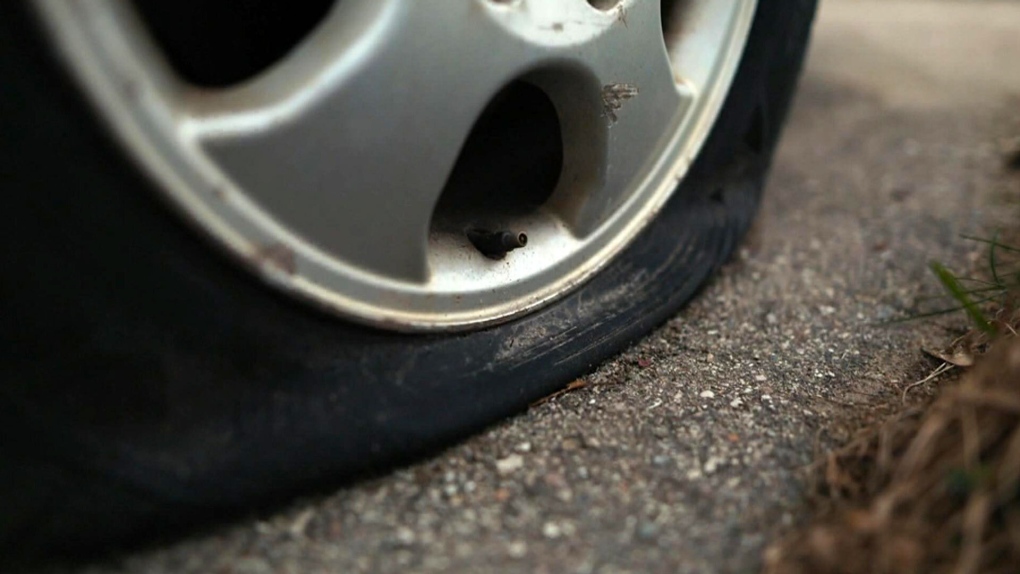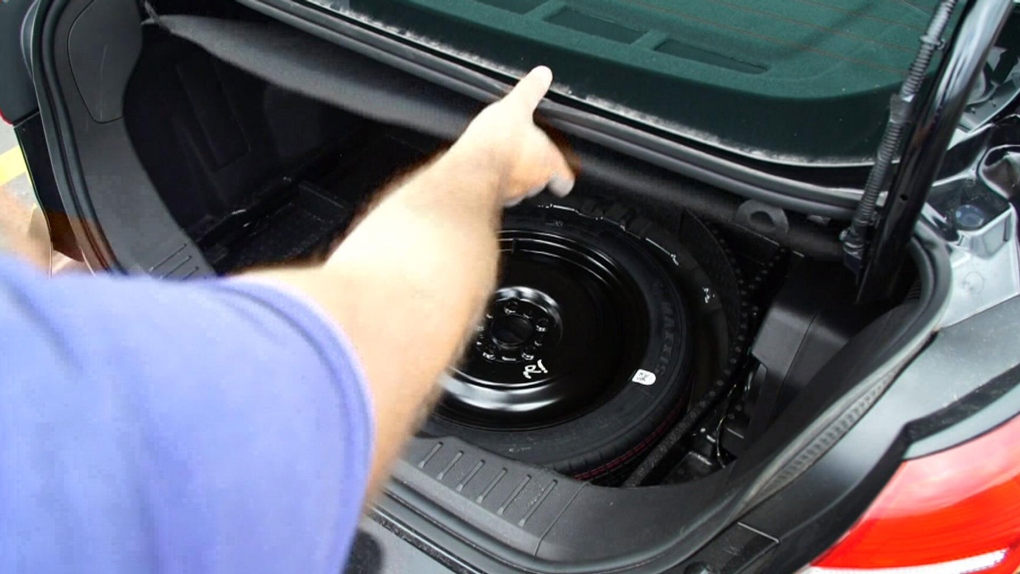More new cars no longer come with a spare tire. Here's what you need to know
If you're driving, it's something you never want to happen, getting a flat tire and ending up on the side of the road.
Luz Plasencia was driving to a spa appointment when she felt a thud.
"Sure enough, I had a flat tire," said Plasencia, who added, "Unfortunately, my car doesn't come with a spare tire."
Vehicles used to come with a "full-sized" spare tire, but about 30 years ago, auto manufacturers moved to a much lighter, smaller tire, sometimes called a "donut spare."
But now, depending on the car you have, it may not have any spare at all.
According to Consumer Reports, if you get a flat, the best advice is safety first.
 Photo shows a car with a flat tire. (CTV News)
Photo shows a car with a flat tire. (CTV News)
"In the event that you do get a flat tire, you should pull off the road as far as you can in a safe area," said Ryan Pszczolkowski with Consumer Reports.
If your car has a space-saver spare tire, you shouldn't forget about it, as it does require your attention.
"Your spare tire expires just like your other four tires," said Pszczolkowski.
To check the age of your spare, look at the last two digits of the DOT number on the sidewall that indicates the year the tire was manufactured, and if it's older than ten years, replace it.
A spare tire only works if it's properly inflated, so check your spare's tire pressure and condition when you check the pressure on your other tires and fill if needed.
Consumer Reports says about 60 per cent of new cars don't come with any spare at all.
"In an effort from the manufacturers to lower production costs and reduce weight for fuel economy, they're just leaving the spare tire out. So don't ever assume you just have a spare tire," said Pszczolkowski.
 A spare tire in the trunk of a car. (CTV News)
A spare tire in the trunk of a car. (CTV News)
Instead, you may get an air compressor or a can of tire sealant that is supposed to patch a damaged tire and get you to a shop where it can be repaired or replaced.
Some cars, mostly luxury models, come with run-flat tires that allow you to continue driving for a set distance, usually 80 kilometres, at modest speeds enough to get you home or to a service center for a replacement.
"You shouldn't be driving around on these tires or a patched tire because that's not a permanent fix," said Pszczolkowski.
The other option is to call for a tow truck and have a new tire installed at an auto shop.
If you're unsure if your car has a spare, it might be a good time to check. Whether you have a spare tire or an inflator kit, you should also know how to use it so you'll be prepared if you get a flat tire.
CTVNews.ca Top Stories

B.C. carjacking suspect sped across U.S. border before arrest, police say
Authorities have arrested a suspect who allegedly carjacked a pickup truck in B.C.'s Lower Mainland then sped across the U.S. border, triggering a massive police response.
Alberta premier says federal border plan coming Monday
The much-anticipated federal plan to address issues at the Canada-U.S. border will be unveiled on Monday according to Alberta Premier Danielle Smith.
Ottawa has sold its stake in Air Canada: sources
Two senior federal government sources have confirmed to CTV News that the federal government has sold its stake in Air Canada. During the COVID-19 pandemic in 2021, the government purchased a six per cent stake in the airline for $500 million as part of a bailout package.
Premiers disagree on whether Canada should cut off energy supply to U.S. if Trump moves ahead with tariffs
Some of Canada's premiers appeared to disagree with Ontario Premier Doug Ford on his approach to retaliatory measures, less than a day after he threatened to cut off the province's energy supply to the U.S. if president-elect Donald Trump follows through on his threat of punishing tariffs.
'Very concerned': Crews search B.C. ski resort for missing man
Police and rescue crews are searching for a man who was last seen boarding a ski lift at B.C.'s Sun Peaks Resort Tuesday.
Man who set fires inside Calgary's municipal building lost testicle during arrest: ASIRT
Two Calgary police officers have been cleared of any wrongdoing in an incident that saw a suspect lose a testicle after being shot with an anti-riot weapon.
Blizzard warning shuts down large parts of midwestern Ontario
It was a day to stay home, if you could, across much of midwestern Ontario due to weather.
Travis Vader, killer of Lyle and Marie McCann, denied day parole
The man who killed an Alberta couple in 2010 has been denied day parole.
She took a DNA test for fun. Police used it to charge her grandmother with murder in a cold case
According to court documents, detectives reopened the cold case in 2017 and then worked with a forensics company to extract DNA from Baby Garnet's partial femur, before sending the results to Identifinders International.


































